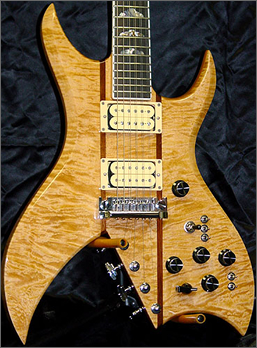 The Bich was launched in 1977 alongside the Seagull and Mockingbird in the BC Rich range of the 1970s. It featured the most daring of BC Rich’s “vintage†designs, with a body originally penned by renowned luthier Neal Moser.
The Bich was launched in 1977 alongside the Seagull and Mockingbird in the BC Rich range of the 1970s. It featured the most daring of BC Rich’s “vintage†designs, with a body originally penned by renowned luthier Neal Moser.
It featured two very unusual cutaways on the bottom of the body, a neck-through design, and originally was only available as a ten-string model (see photo), which had 4 tuning pegs at the bridge end for the 4 extra top strings.
However, this limited the appeal of the guitar somewhat, and so a normal six string was launched soon after. It featured all the usual other trimmings on 1970s BC Riches, including elaborate coil-splitting functions and a dizzying array of switches and knobs..
Master Volume, Rhythm Pickup Volume, Pre-amp #1 Volume, Pre-amp #1 On/Off, Pre-amp #2 Volume, Pre-amp #2 On/Off, Phase Switch, Pickup Selector, Six Position Varitone, Dual Sound Rhythm Pickup, Dual Sound Lead Pickup and Master Tone.
When all switches are off the guitar is in passive mode. At this time both pickups are controlled by the master volume. Both pick-ups are activated by pick up selector switch. The tonalities of both pickups in passive mode are controlled by the Master Tone.
Click on the preamp On/Off switch and get an instant 10 db boost from the gate. At this point the pick-ups are now controlled by the pick-up volume control while the master tone still controls the tonality of both pick-ups. With both pick-ups on, phase switch in the up position will produce an out of phase sound, (a tone resembling a half cocked wah sound).
To coil tap the lead pickup flick upward dual sound switch. This converts the pick-up into a single coil sound by separating the pick-up into one coil. Dual sound switch #6 performs the same task for the rhythm pick-up.
As you rotate the six-position varitone clockwise, each position produces a distinct sound based on whichever capacitor is in operation. You will also notice a slight decrease in gain but the pre amp volume can compensate the drop and then some. It is only as limited as your imagination.
All these switches can be use to your liking & when you find a particular sound you like, make note of the setting for future reference. The B.C. Rich Active Electronics produces a spectrum of 154 distinct sounds. If you really want to get really funky with all switches on as described rotate master tone counter clockwise. If you are a traditional blues player you will find sounds you never knew existed. Note that all pickups function while in passive as well as active mode. The battery can easily be changed by carefully removing the screws for the control cavity plate.
The main difference between the active and full active electronics system is that the full electronics system has two independent preamps as well as two volume switches which can work in unison or individually and can naturally distort the volume even at low settings.
The B.C. Rich Active and Full Active systems offer more sounds than any other onboard electronics.
The Bich is still available and is a very popular model in BC Rich’s line. It is available as a ten string, six string, bolt-on and through-neck versions, with prices starting from around £250. However, like other older BC Riches, the 1970s versions command upwards of £1000 when on sale.



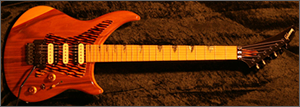 The guitar featured an updated Stratocaster shape with a reverse headstock, and had a set-neck when the trend in Superstrat design was to have a thru-neck, or a bolt-on for the cheaper models.
The guitar featured an updated Stratocaster shape with a reverse headstock, and had a set-neck when the trend in Superstrat design was to have a thru-neck, or a bolt-on for the cheaper models.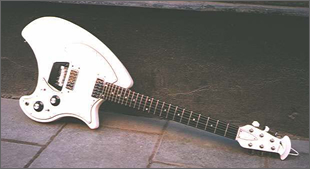 While the former three were fairly normal in design, albeit with traditional Ovation touches in the shapes, the Deacon and Breadwinner seemed almost mutated in comparison, with their bodies shaped somewhat like axes. They also had active mini-humbuckers, rare in the 1970s.
While the former three were fairly normal in design, albeit with traditional Ovation touches in the shapes, the Deacon and Breadwinner seemed almost mutated in comparison, with their bodies shaped somewhat like axes. They also had active mini-humbuckers, rare in the 1970s.
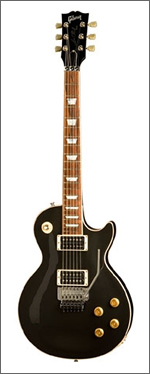 Mark (the manager) and Matt couldn’t have been more friendly and helpful, allowing us to grab whatever guitars we fancied and wailing away with Boogie and Engl amps in their nice  (soundproof!) testing rooms.
Mark (the manager) and Matt couldn’t have been more friendly and helpful, allowing us to grab whatever guitars we fancied and wailing away with Boogie and Engl amps in their nice  (soundproof!) testing rooms. The guitar was unusual in shape, with a 25 1/2″ scale length similar to an ES-335, but with much sharper double florentine cutaways, resembling an SG.
The guitar was unusual in shape, with a 25 1/2″ scale length similar to an ES-335, but with much sharper double florentine cutaways, resembling an SG.
 Ibanez received a cease- and-desist order and decided to make more original models. This culminated in the Iceman and Destroyer of the late 1970s. The Destroyer started in 1975 as a very impressive Gibson Explorer copy also called Model 2459, but was phased out around a year later.
Ibanez received a cease- and-desist order and decided to make more original models. This culminated in the Iceman and Destroyer of the late 1970s. The Destroyer started in 1975 as a very impressive Gibson Explorer copy also called Model 2459, but was phased out around a year later. The Bich was launched in 1977 alongside the Seagull and
The Bich was launched in 1977 alongside the Seagull and 
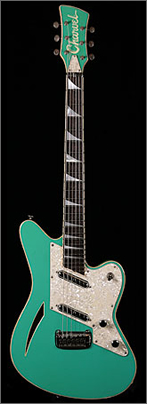 The Charvel company, which spawned the famous and reputable brand Jackson Guitars, is also well known for their very high-quality superstrat models and for a while was the chief supplier of Eddie Van Halen’s guitars. In 1992 Charvel launched their biggest break from their usual superstrat tradition (the company also dabbles in Telecaster-shaped models and four-pointed star-shaped models).
The Charvel company, which spawned the famous and reputable brand Jackson Guitars, is also well known for their very high-quality superstrat models and for a while was the chief supplier of Eddie Van Halen’s guitars. In 1992 Charvel launched their biggest break from their usual superstrat tradition (the company also dabbles in Telecaster-shaped models and four-pointed star-shaped models).
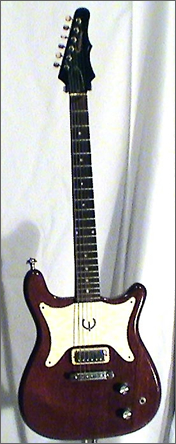 The Epiphone Coronet was launched in 1958 as an alternative to the popular Gibson Les Paul Junior. It was part of a range of models made from the late 50s to 1970. The range included the Crestwood, Coronet
The Epiphone Coronet was launched in 1958 as an alternative to the popular Gibson Les Paul Junior. It was part of a range of models made from the late 50s to 1970. The range included the Crestwood, Coronet 
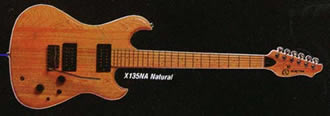 The Phoenix was the best known of Electra’s original models, a vaguely Strat-shaped guitar available as a series of 10-15 different models. The one featured on the site , I believe to be a Phoenix X135 model. This model featured an ash or maple body (the one for sale looks maple to me), and two coil-tapped humbucking pickups. This one is in a natural finish and is possibly an earlier model due to the inclusion of a scratchplate.
The Phoenix was the best known of Electra’s original models, a vaguely Strat-shaped guitar available as a series of 10-15 different models. The one featured on the site , I believe to be a Phoenix X135 model. This model featured an ash or maple body (the one for sale looks maple to me), and two coil-tapped humbucking pickups. This one is in a natural finish and is possibly an earlier model due to the inclusion of a scratchplate.